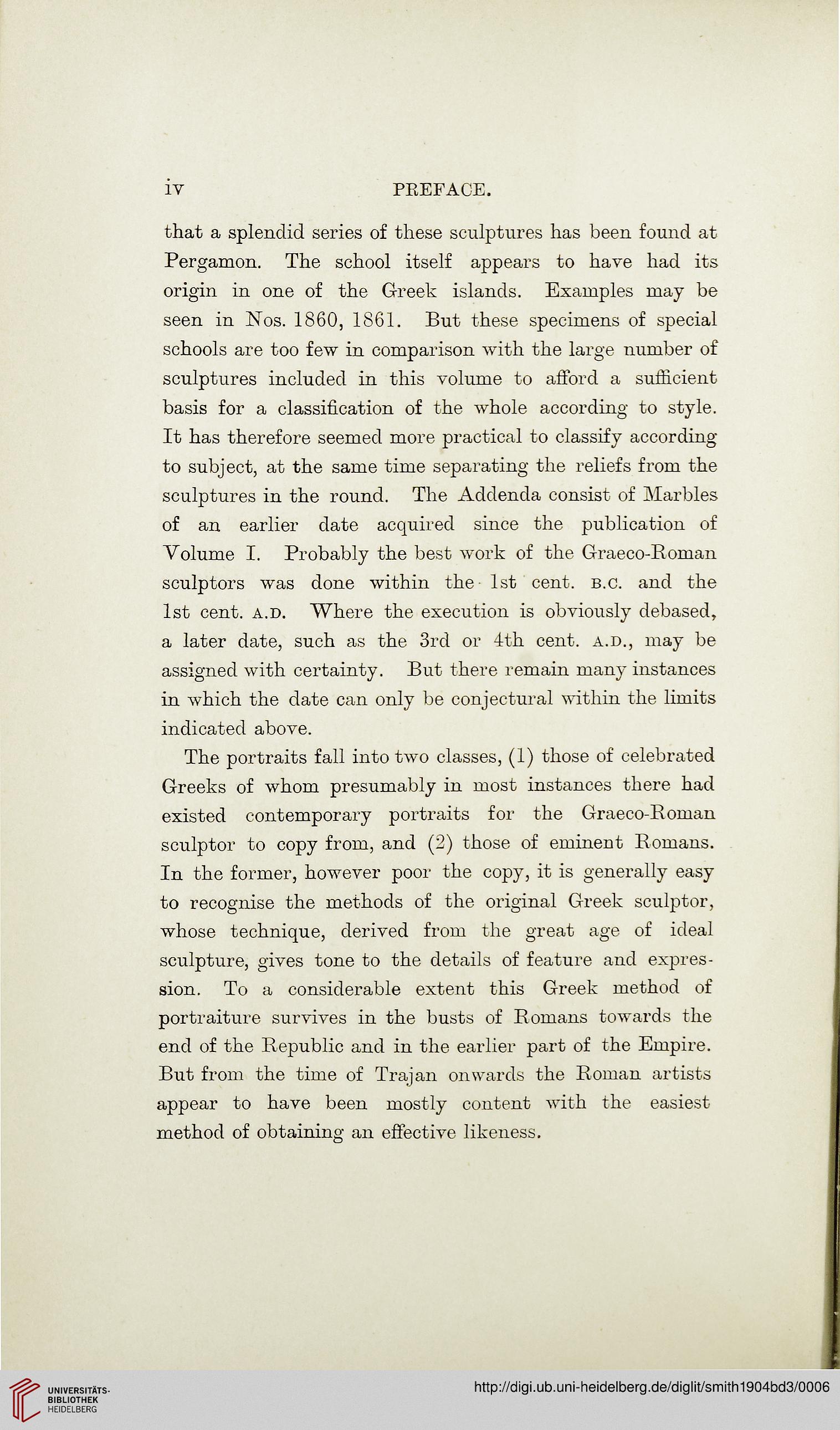iv
PREFACE.
that a splendid series of these sculptures has been found at
Pergamon. The school itself appears to have had its
origin in one of the Greek islands. Examples may be
seen in Nos. 1860, 1861. But these specimens of special
schools are too few in comparison with the large number of
sculptures included in this volume to afford a sufficient
basis for a classification of the whole according to style.
It has therefore seemed more practical to classify according
to subject, at the same time separating the reliefs from the
sculptures in the round. The Addenda consist of Marbles
of an earlier date acquired since the publication of
Volume I. Probably the best work of the Graeco-Roman
sculptors was done within the 1st cent. b.c. and the
1st cent. a.d. Where the execution is obviously debased,
a later date, such as the 3rd or 4th cent, a.d., may be
assigned with certainty. But there remain many instances
in which the date can only be conjectural within the limits
indicated above.
The portraits fall into two classes, (1) those of celebrated
Greeks of whom presumably in most instances there had
existed contemporary portraits for the Graeco-Roman
sculptor to copy from, and (2) those of eminent Romans.
In the former, however poor the copy, it is generally easy
to recognise the methods of the original Greek sculptor,
whose technique, derived from the great age of ideal
sculpture, gives tone to the details of feature and expres-
sion. To a considerable extent this Greek method of
portraiture survives in the busts of Romans towards the
end of the Republic and in the earlier part of the Empire.
But from the time of Trajan onwards the Roman artists
appear to have been mostly content with the easiest
method of obtaining an effective likeness.
PREFACE.
that a splendid series of these sculptures has been found at
Pergamon. The school itself appears to have had its
origin in one of the Greek islands. Examples may be
seen in Nos. 1860, 1861. But these specimens of special
schools are too few in comparison with the large number of
sculptures included in this volume to afford a sufficient
basis for a classification of the whole according to style.
It has therefore seemed more practical to classify according
to subject, at the same time separating the reliefs from the
sculptures in the round. The Addenda consist of Marbles
of an earlier date acquired since the publication of
Volume I. Probably the best work of the Graeco-Roman
sculptors was done within the 1st cent. b.c. and the
1st cent. a.d. Where the execution is obviously debased,
a later date, such as the 3rd or 4th cent, a.d., may be
assigned with certainty. But there remain many instances
in which the date can only be conjectural within the limits
indicated above.
The portraits fall into two classes, (1) those of celebrated
Greeks of whom presumably in most instances there had
existed contemporary portraits for the Graeco-Roman
sculptor to copy from, and (2) those of eminent Romans.
In the former, however poor the copy, it is generally easy
to recognise the methods of the original Greek sculptor,
whose technique, derived from the great age of ideal
sculpture, gives tone to the details of feature and expres-
sion. To a considerable extent this Greek method of
portraiture survives in the busts of Romans towards the
end of the Republic and in the earlier part of the Empire.
But from the time of Trajan onwards the Roman artists
appear to have been mostly content with the easiest
method of obtaining an effective likeness.




